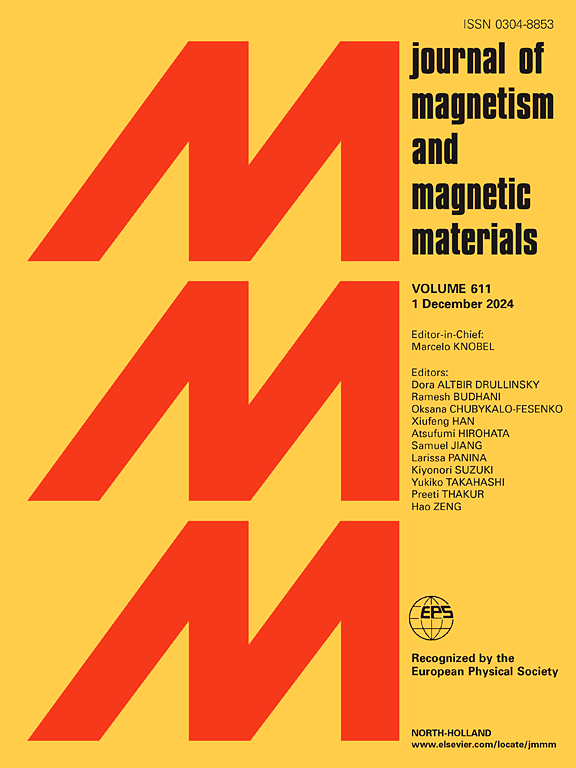热处理后烧结钕铁硼磁体冷喷涂Al涂层的耐蚀性、力学性能和磁性能
IF 2.5
3区 材料科学
Q3 MATERIALS SCIENCE, MULTIDISCIPLINARY
引用次数: 0
摘要
采用冷喷涂的方法在烧结钕铁硼基体上沉积了一层保护性铝涂层。在450°C、500°C和550°C下进行后续退火以改善涂层磁体的性能。然后,研究了热处理温度对烧结钕铁硼磁体上冷喷涂Al涂层的耐蚀性、力学性能和磁性能的影响。结果表明,热处理后的涂层具有较高的腐蚀电位和较低的腐蚀电流密度,具有较好的耐蚀性。随着热处理温度的升高,抗腐蚀倾向增强。Al包覆NdFeB的平均结合强度由处理前的20.69±1.71 MPa提高到450℃处理时的49.23±2.21 MPa,表明热处理后可以显著提高Al包覆在NdFeB基体上的结合强度。与烧结钕铁硼相比,al包覆钕铁硼的最大磁能积和剩磁率分别下降了16.8%、2.3%和9.4%。热处理后,al包覆钕铁硼的最大磁能积和剩余量均较未处理样品增大,且随着热处理温度的升高,最大磁能积和剩余量进一步增大。热处理后的本征矫顽力场值减小,随热处理温度的升高而略有波动。结果异常的原因可能是冷喷涂过程中涂层中产生了NdFeB碎屑。本文章由计算机程序翻译,如有差异,请以英文原文为准。
Corrosion resistance, mechanical and magnetic properties of cold-sprayed Al coating on the sintered NdFeB magnet after heat treatment
A protective aluminum coating was deposited on the sintered NdFeB substrate by cold spray. A follow-up annealing at 450 °C, 500 °C and 550 °C was carried out to improve the properties of the coated magnet. Then, the effects of heat treatment temperature on the corrosion resistance, mechanical and magnetic properties of the cold-sprayed Al coatings on the sintered NdFeB magnet were studied. It was found that a higher value of corrosion potential and a lower value of corrosion current density for the heat-treated coating, exhibiting better corrosion resistance. And, the tendency of anti-corrosion improved with the temperature of heat treatment rise. The average bonding strength of the Al-coated NdFeB increased from 20.69 ± 1.71 MPa before treatment to 49.23 ± 2.21 MPa (treated at 450 °C), indicating that post heat treatment can significantly improve the bonding strength of the Al coating on the NdFeB substrate. The maximum magnetic energy product, and remanence decreased for the Al-coated NdFeB compared with the sintered NdFeB, with the different amplitude of 16.8 %, 2.3 %, 9.4 %, respectively. After heat treatment, the value of maximum magnetic energy product and remanence of the Al-coated NdFeB increased compared with untreated samples, and the value increased further as the temperature of heat treatment rise. But, the value of the intrinsic coercive field reduced after heat treatment, and the value fluctuated slightly as the temperature of heat treatment rise. The reasons for the abnormal results could be attribute to the NdFeB debris in the coating generated from the process of cold spray.
求助全文
通过发布文献求助,成功后即可免费获取论文全文。
去求助
来源期刊

Journal of Magnetism and Magnetic Materials
物理-材料科学:综合
CiteScore
5.30
自引率
11.10%
发文量
1149
审稿时长
59 days
期刊介绍:
The Journal of Magnetism and Magnetic Materials provides an important forum for the disclosure and discussion of original contributions covering the whole spectrum of topics, from basic magnetism to the technology and applications of magnetic materials. The journal encourages greater interaction between the basic and applied sub-disciplines of magnetism with comprehensive review articles, in addition to full-length contributions. In addition, other categories of contributions are welcome, including Critical Focused issues, Current Perspectives and Outreach to the General Public.
Main Categories:
Full-length articles:
Technically original research documents that report results of value to the communities that comprise the journal audience. The link between chemical, structural and microstructural properties on the one hand and magnetic properties on the other hand are encouraged.
In addition to general topics covering all areas of magnetism and magnetic materials, the full-length articles also include three sub-sections, focusing on Nanomagnetism, Spintronics and Applications.
The sub-section on Nanomagnetism contains articles on magnetic nanoparticles, nanowires, thin films, 2D materials and other nanoscale magnetic materials and their applications.
The sub-section on Spintronics contains articles on magnetoresistance, magnetoimpedance, magneto-optical phenomena, Micro-Electro-Mechanical Systems (MEMS), and other topics related to spin current control and magneto-transport phenomena. The sub-section on Applications display papers that focus on applications of magnetic materials. The applications need to show a connection to magnetism.
Review articles:
Review articles organize, clarify, and summarize existing major works in the areas covered by the Journal and provide comprehensive citations to the full spectrum of relevant literature.
 求助内容:
求助内容: 应助结果提醒方式:
应助结果提醒方式:


